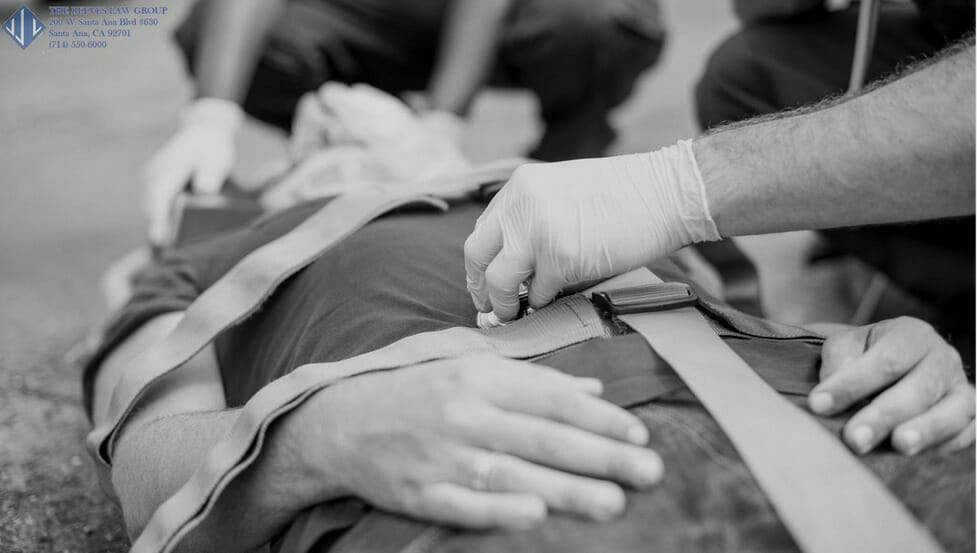
While car accident injuries differ from person to person and from crash to crash, some vehicle-related injuries are quite serious. This article provides a comprehensive overview of the most frequent vehicle accident injuries. More precise information for a particular instance should always be received from a doctor.
Below are common car accident injuries:
Bruising
Bruises are often minor and heal within a week or two. In a car accident, the seat belt can cause bruising while protecting you from more severe injuries.
Most bruises are harmless, but if you sustain one in a car accident, you should monitor it. It could be an indication of something worse. Some bruises can be significantly more severe and pierce the bone, or cause a blood clot.
A bruise on a victim of an accident may indicate internal bleeding. If the bruise develops a hematoma or contusion, it may mean a more serious injury beneath. Pay close attention to any head abrasions. They may indicate brain damage, which can progress rapidly.
Indicators that a bruise may indicate a more serious injury include:
- Loss of mobility, weakness, numbness, or “asleep” pins and needles
- Enhanced inflammation or discomfort
- Nausea and vomiting
- Vision problems and headaches
- Not healing in a week or just getting worse
- Blood in the urine
- Quick pulse, fever, or shallow vision
- Loss of motion, especially in the legs
- Any head injuries
- Any abdomen injuries
Scars And Disfiguration
Burns and facial injuries can leave disfiguring scars that alter a person’s appearance. These can necessitate reconstructive and plastic surgery, which may never completely disappear. In addition, if the victim of a car accident is in a customer- or audience-facing position, facial disfigurement may hinder their future employment prospects.
Scars can also cause further long-term issues such as depression and anxiety.
Certain scars contract as they heal, reducing mobility in the affected area. A scar can develop into a keloid, or large raised area. Scars can quickly get infected or inflamed throughout the healing process, requiring extra medical treatment.
Broken Bones
Bone breaks and fractures caused by a heavy impact, such as an auto accident, are not always immediately obvious at the time of the encounter. Only later pain and other issues can serve as a warning sign.
Chest injuries and broken ribs are also typical seat belt-related injuries. (Despite the fact that seat belts save lives and prevent more severe injuries.)
Types of bone fractures:
- Displaced Fracture
- Non-Displaced Fracture
- Open Fracture
- Close Fracture
- Stress Fracture
- Partial Fracture
Facial Injuries
Facial and skull injuries are challenging to treat. In this area, the brain and major sensory organs are located. In addition to the fragile parts of the brain, the eyes, nose, mouth, and ears are also susceptible to injury.
- Bone fractures
- Lacerations
- Eye injuries
- Soft tissue injuries
- Burns
- Facial deformities
- Tooth loss
Neck Injuries
The neck is a thin foundation for the head. The neck’s muscles, cartilage, tendons, and other soft tissues can be injured by jolting the body.
The cause of whiplash is an abrupt forward and backward movement of the neck. The movement is identical to the cracking of a whip. Whiplash and other invisible injuries can take months to heal or result in a lifetime of agony.
Your head is roughly 11 pounds in weight. However, if you have been in an accident and your head is propelled forward quickly, it can feel as if it weighs 60 pounds, resulting in numerous neck ailments. Additionally, the steering wheel and airbags can cause neck injuries that require medical attention.
Whiplash
According to the Mayo Clinic, 120,000 people suffer whiplash injuries annually. Whiplash is the most common injury in car accidents, and rear-end crashes frequently cause it. It can be quite painful and traumatic, but it often heals within a few weeks.
Symptoms of whiplash:
- Neck pain and stiffness
- Neck movement aggravate pain
- Loss of mobility in the neck
- Headaches
- Upper back, shoulder, or arm pain
- Fatigue
- Tingling and numbness
- Dizziness
Loss Of Limbs
Automobile accidents can completely amputate a limb or cause so serious damage that the limb must be removed in whole or part. Amputation results in expensive and time-consuming rehabilitation, prostheses, and other assistive devices. It might severely restrict your regular activities.
In the United States, around 1.7 million people live with limb loss. One in 200 individuals, according to the National Limb Loss Information Center.
Wrist & Hand Injuries
If you raise your hands to protect yourself during an automobile accident, they could sustain severe injuries as they come into contact with parts of the car or the ground. The delicate bones of the hand and wrist have a complex relationship with one another. You may require surgery, and while it heals, you may lose several functions.
In addition to dislocation, occasionally, finger and toe amputation damage can occur.
Leg & Foot Injuries
Drivers are particularly susceptible to leg and foot problems. While driving with their legs stretched forward, these bones and tissues might absorb the pressure of a forward collision, resulting in leg injuries. The foot, like the hand, is composed of several tiny bones that are easily broken or dislodged.
Brain Injuries
Vehicle collisions can cause Traumatic Brain Injuries (TBIs). Most brain injuries are caused by falls, gunfires, and motor vehicle accidents. TBIs are notoriously difficult to detect and diagnose. Minor issues with memory, brain, and body functions may indicate a more severe brain injury.
TBIs are a type of head injury that includes head bumps/blows and piercing injuries, with concussions being the mildest form of brain damage. More severe cases can result in death or lifelong complications.
A TBI can impede a child’s cognitive development and may necessitate lifelong medical care for an adult. Each year, TBIs result in around 2.8 million emergency room visits, hospitalizations, and 50,000 deaths.
Concussions
In a concussion, the intense movement of the brain ceases abruptly. It causes the brain to move erratically within the skull, causing it to twist or stretch out of shape. This unexpected occurrence frequently causes chemical changes in the brain that result in additional complications.
Every concussion has the potential to be life-threatening and severe. Unlike a broken bone, a brain injury cannot be directly observed. You may believe it’s just a bump, but there’s a terrible wound in your head. Brain injuries can produce bruising, bleeding, or ripping.
A succession of concussions can gradually exacerbate brain damage.
Burns
A car accident might cause people to come into contact with fire or even automotive parts they would not typically touch. Burns can be severe if hot engine parts or substances are sprayed. It is possible for an entire vehicle to explode into flames, resulting in death or life-threatening burns to huge portions of the body.
Post-Traumatic Stress
Post-traumatic stress disorder (PTSD) can be caused by a system shock, such as a vehicle crash. You may get visions or see flashes of your accident anytime you attempt to enter a vehicle. PTSD can hinder your ability to engage in your favorite hobbies. It can also result in difficulty of sleeping and nightmares, as well as other mental illnesses like depression.
Even without PTSD, car accidents can leave permanent mental and emotional scars. Consultation with a psychologist or therapist following an injury is normal.
Back Injuries
In a car accident, a range of back injuries is possible (usually caused by a rear-end accident). Back pain is one of the most excruciating types of body pains. In car accidents, back injuries frequently lead to permanent disability.
Those who are unable to return to work face a lifetime of disabilities.
Among the several types of back injuries are:
- Strain
- Sprain
- Slipped or herniated disc
- Ruptured disc
- Pinched nerve
- Nerve damage
Paralysis
Injuries to the spinal cord and other major injuries can cause paralysis.
Partial or total paralysis can occur at the part of the damage. Accidents involving motor vehicles account for roughly half of all spinal cord injury cases. A hit to the back typically results in paralysis by dislocating or fracturing vertebrae and ripping or bruising the spinal cord.
There is no treatment for spinal cord damage. It is likely to result in a lifetime of operations, physical therapy, pain management, and the use of a wheelchair or other mobility aid.
Paralysis causes the inability to move one or both arms or legs, but it also has the following effects:
- Loss of feeling and touch
- Loss of movement
- Loss of experiencing heat or cold
- Chronic pain
- Spasms
- Large reflex actions
- Difficulty breathing
- Infertility
What To Do If You’re Injured In a Car Accident
Every day, automobile collisions cause terrible injuries to countless individuals.
Even without a vehicle, bicyclists and pedestrians are statistically susceptible to car accident injuries.
You may feel overwhelmed and confused about what to do after a car accident.
Dealing with the aftermath of a car accident can be quite stressful. You may have questions about your legal options and rights but may not know where to find assistance.
If you’ve been injured in an accident, a car accident attorney at Reeves Law Group can help you evaluate your eligibility for compensation and guide you through the steps necessary to file a lawsuit.
Reference sources or statistics:
- https://www.nhtsa.gov/press-releases/early-estimate-2021-traffic-fatalities#:~:text=NHTSA%20projects%20that%20an%20estimated,Fatality%20Analysis%20Reporting%20System’s%20history.
- https://en.wikipedia.org/wiki/Motor_vehicle_fatality_rate_in_U.S._by_year
- https://www.iihs.org/topics/fatality-statistics/detail/state-by-state
- https://injuryfacts.nsc.org/motor-vehicle/historical-fatality-trends/deaths-and-rates/
- https://www.cnbc.com/2022/05/17/us-traffic-deaths-hit-16-year-high-in-2021-dot-ays.html
- https://worldpopulationreview.com/state-rankings/fatal-car-accidents-by-state
- https://www.who.int/news-room/fact-sheets/detail/road-traffic-injuries
- https://driving-tests.org/driving-statistics/
- https://www.iii.org/fact-statistic/facts-statistics-highway-safety
- https://www.driverknowledge.com/car-accident-statistics/










